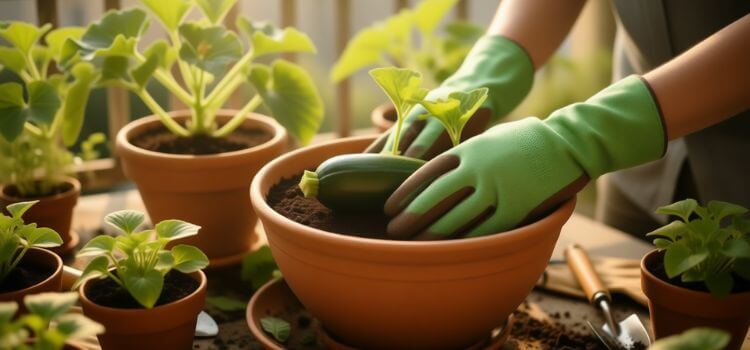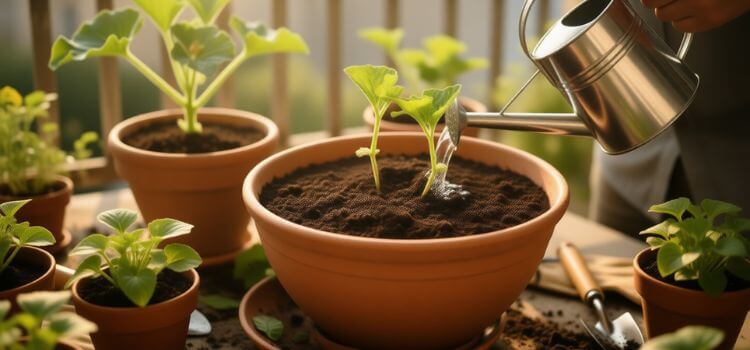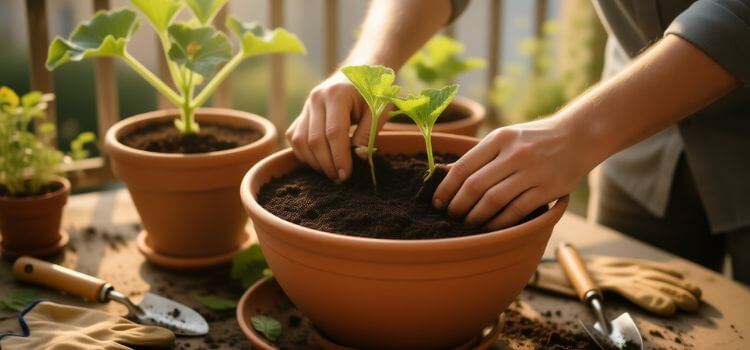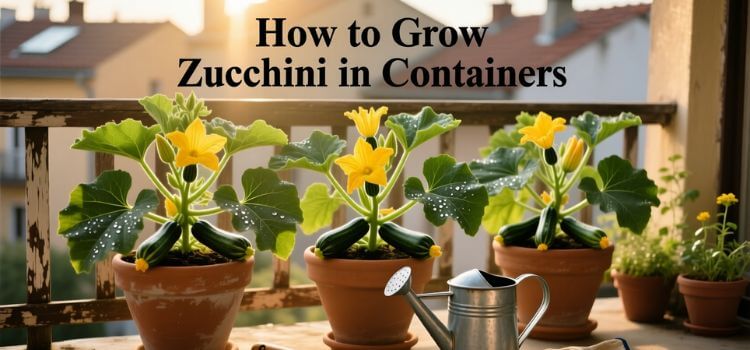As an Amazon Associate, I earn from qualifying purchases.
Have you ever looked at a beautiful zucchini plant and thought, “Can I grow that in a small space?” The good news is — yes, you absolutely can! Learning how to grow zucchini in containers is one of the easiest ways to enjoy fresh, homegrown vegetables without needing a big backyard.
I still remember my first try at growing zucchini. I had a few old containers, some soil, and a lot of curiosity. To my surprise, within weeks, those small seedlings turned into leafy green plants that gave me more zucchinis than I could cook! It felt magical — like growing my own little farm on the balcony.
Zucchini, or courgette as some call it, is a fast-growing summer vegetable. It doesn’t require much space, making it perfect for people living in apartments or houses with small yards. All you need is sunlight, good soil, water, and a little care.
If you’ve ever felt sad watching vegetables wilt in the market or worried about chemicals in store-bought ones, then growing your own zucchini will make you feel proud. Imagine plucking a fresh green zucchini and turning it into a delicious curry or stir-fry. Sounds satisfying, right?
In this article, I’ll show you step-by-step how to grow zucchini in containers — even if you’re a total beginner. I’ll share real tips, mistakes I made, and secrets that helped my plants thrive. Ready? Let’s dig in!

What You Need Before Planting Zucchini in Containers
Before jumping into planting, let’s talk about what you’ll need. Think of this like preparing your kitchen before cooking — you’ll enjoy the process more when everything’s ready.
1. Choose the Right Container
Zucchini plants grow fast and wide. They need space for roots to stretch. Pick a container at least 18–24 inches deep and wide. Plastic, ceramic, or even a recycled bucket can work fine as long as it has drainage holes. Without holes, roots may rot — and trust me, that’s a sad sight for any gardener.
Pro tip: Use lightweight containers if you plan to move them around for sunlight.
2. Best Soil for Zucchini
Zucchini loves rich, well-draining soil. You can mix 40% garden soil, 40% compost, and 20% coco peat or perlite. This combo keeps the soil loose and nutrient-rich. If you can, add some organic fertilizer or well-rotted manure.
Remember — healthy soil means healthy plants.
3. Selecting Seeds or Seedlings
You can grow zucchini either from seeds or small starter plants. Seeds are cheaper and fun to start with. Go for compact or bush varieties like ‘Black Beauty’ or ‘Patio Star’. They grow well in containers and don’t spread too much.
4. Sunlight & Temperature
Zucchini is a sun-lover. It needs 6–8 hours of sunlight daily. If your space doesn’t get that much light, try placing mirrors or white surfaces nearby to reflect sunlight. Temperature between 20°C–30°C (68°F–86°F) is ideal.
It’s like giving your plant a warm, cozy bed to sleep in every day.
How to Plant Zucchini in Containers (Step-by-Step)
Now that your materials are ready, let’s get those green beauties growing!
Step 1: Prepare the Container
Fill your pot with the soil mix, leaving about 2 inches at the top. Don’t press too hard — zucchini roots like breathing space.
Step 2: Plant the Seeds
Make small holes about 1 inch deep. Drop 2–3 seeds per container and cover them gently with soil. Water lightly.
After 7–10 days, you’ll see cute green sprouts popping up. When the seedlings reach 3–4 inches tall, keep the strongest one and gently remove the weaker ones.
Step 3: Watering Right
Zucchini loves moisture but hates being waterlogged. Water deeply when the top inch of soil feels dry.
During hot days, watering every morning works best. Imagine giving your plants a refreshing morning drink!
Step 4: Feeding the Plant
Every 2–3 weeks, feed your zucchini with organic liquid fertilizer like compost tea or seaweed extract.
Think of it as giving your plant a healthy smoothie for extra energy.
Step 5: Support & Pruning
As the plant grows, add a small stake or trellis for support. Remove yellow leaves or old stems so air can flow easily. This keeps the plant healthy and prevents fungal diseases.

Caring for Your Zucchini Plants (Like a Pro!)
1. Pollination Matters
Zucchini has both male and female flowers. Bees usually do the pollination job. But if you don’t see bees around, you can hand-pollinate. Just take a small brush, touch the male flower (it has pollen), and gently brush it onto the female flower (with a tiny baby zucchini behind it).
It’s like playing matchmaker for your plants — and trust me, it’s oddly satisfying!
2. Pest Control Naturally
You might meet some uninvited guests like aphids or squash bugs. Don’t panic. Mix neem oil and water and spray it once a week.
Also, keep the area clean and avoid overwatering — pests love damp places.
3. Harvesting Time
Within 45–60 days, you’ll start seeing zucchinis ready for harvest. Pick them when they’re about 6–8 inches long.
If you wait too long, they get big and lose their sweet flavor. Harvest regularly — it encourages more fruits to grow.
Quick Guide to Growing Zucchini in Containers
| Step | What to Do | Key Tip |
|---|---|---|
| 1 | Choose container (18–24 in deep) | Ensure good drainage |
| 2 | Mix soil (garden + compost + coco peat) | Keep it loose & rich |
| 3 | Plant seeds (1 inch deep) | 2–3 seeds per pot |
| 4 | Water regularly | Moist, not soggy soil |
| 5 | Fertilize every 2–3 weeks | Use organic feed |
| 6 | Provide sunlight | 6–8 hours daily |
| 7 | Hand-pollinate if needed | Use soft brush |
| 8 | Harvest at 6–8 inches | Encourages new growth |
Common Mistakes to Avoid When Growing Zucchini in Containers
I’ve made plenty of mistakes — so let me help you skip them.
- Overwatering: Zucchini roots hate standing water.
- Too many plants per container: One plant per large pot is perfect.
- Lack of sunlight: Less sun = fewer zucchinis.
- Skipping fertilizer: Hungry plants give smaller fruits.
- Ignoring pests: A few bugs can become a big problem fast.
Note: The secret to growing perfect zucchini isn’t just care — it’s observation. Look at your plants daily; they’ll “tell” you what they need.

My Balcony Zucchini Story
When I first tried growing zucchini, my biggest fear was space. My balcony was small, and I thought vegetables needed big gardens. Still, I planted two seeds in a 20-inch pot.
I watched them grow like proud children — from tiny leaves to a green jungle. Every morning, I’d check to see if any new flowers had appeared. When I finally harvested my first zucchini, I made a simple stir-fry. The taste? Fresh, soft, and pure joy!
So if I can do it with limited space, you can too. It’s all about giving your plants love, care, and sunlight.
FAQs: Answering Your Zucchini Questions
1. Can zucchini really grow well in containers?
Yes! Zucchini grows beautifully in containers if given enough space, sunlight, and nutrients. Choose bush varieties for better results. They produce plenty of fruits even in small spaces.
2. How often should I water my zucchini plant?
Water when the top inch of soil feels dry. On hot days, that might be daily. Avoid overwatering; roots need air too. Always check the soil before watering.
3. What’s the best fertilizer for container zucchini?
Use organic compost or liquid fertilizer every 2–3 weeks. Avoid chemical fertilizers — they may harm the soil and plant health over time.
4. Why are my zucchini flowers falling off?
Don’t worry — male flowers fall naturally after pollination. If both types fall off, check sunlight, watering, and nutrition. Hand-pollination can also help.
5. How long does it take to grow zucchini from seed?
Usually 45–60 days from planting to harvest. With proper care, you can enjoy continuous harvests all summer long.
Conclusion
Growing zucchini in containers isn’t just about vegetables — it’s about patience, joy, and connecting with nature. Every seed you plant carries hope. Every new leaf reminds you that small efforts bring big rewards.
When you harvest your first zucchini, you’ll feel a happiness money can’t buy. It’s that “I did it myself” pride that makes gardening magical.
So, go ahead — find a container, grab some soil, and plant your zucchini seeds today. Your homegrown harvest will not only feed your body but also your heart.

